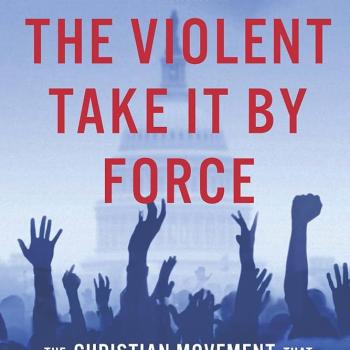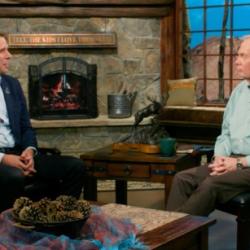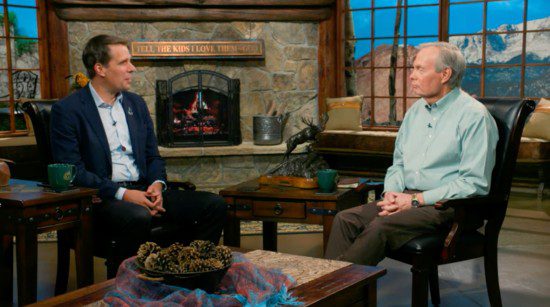President Donald Trump’s core supporters are celebrating his announcement earlier this month that the United States will be moving it’s embassy in Israel from Tel Aviv to Jerusalem. This is something white evangelical Americans have been wanting to see for many years, and they’re elated it’s finally happening.
What’s that all about? Well, it has to do with “Bible prophecy.” And with white evangelicals’ insistence that America must demonstrate “support for Israel.”*
Some really smart people who understand this particular intersection of sectarian Protestantism and foreign policy have written a bunch of very good articles providing an overview of just why this is something of such great concern for white American evangelicals. I recommend all of these:
• Julie Ingersoll, “Why Trump’s evangelical supporters welcome his move on Jerusalem“
• Sean Illing, “This is why evangelicals love Trump’s Israel policy“
• Diana Butler Bass, “For many evangelicals, Jerusalem is about prophecy, not politics“
• Jonathan Merritt, “Understanding the Evangelical obsession with Israel“
• Matthew Avery Sutton, “Jerusalem: Trump’s gift to evangelicals“
Julie Ingersoll and Matthew Avery Sutton, in particular, put their finger on just what makes this announcement so exciting for Rapture Christians. Here’s Ingersoll:
The nation of Israel and the role of the city of Jerusalem are central in the “end-times” theology – a form of what is known as “pre-millennialism” – embraced by many American conservative Protestants.
While this theology is often thought of as a “literal” reading of the Bible, it’s actually a reasonably new interpretation that dates to the 19th century and relates to the work of Bible teacher John Nelson Darby.
According to Darby, for this to happen the Jewish people must have control of Jerusalem and build a third Jewish temple on the site where the first and second temples – destroyed centuries ago by the Babylonians and Romans – once were. In Darby’s view this was a necessary precursor to the rapture, when believers would be “taken up” by Christ to escape the worst of the seven-year-period of suffering and turmoil on Earth: the Great Tribulation. This is to be followed by the cosmic battle between good and evil called Armageddon at which Satan will be defeated and Christ will establish his earthly kingdom. All of this became eminently more possible when the modern state of Israel was established in the 1940s.
And here’s Sutton:
For the last century and a half, a long line of evangelical preachers, theologians and media personalities have insisted that the re-establishment of a homeland for the Jewish people with Jerusalem as its capital would set the stage for Jesus’ Second Coming.
In recent years, best-selling authors and theologians have reinforced such conclusions.
In the 1970s, the heavily mustachioed, Mississippi-River-tugboat-captain-turned-evangelist Hal Lindsey published “The Late Great Planet Earth,” a book that sold more copies in the 1970s than any other work of nonfiction in the United States. It has remained in print ever since.
Israel occupied the center of Lindsey’s analysis. He believed that as the world moved toward the battle of Armageddon, three events would occur. First, the Jews would retake Palestine. Second, they would repossess old Jerusalem and its sacred sites. Third, they would rebuild King Solomon’s temple on its original historical site.
The first of these steps was accomplished in 1948 with the creation of the state of Israel. The second occurred in 1967 when Israel captured Jerusalem during the Six Day War. The final event has not happened. Yet.
It’s all about dates and check lists and the final countdown. And, as Sutton says, the key date for late-20th-century Rapture Christians was the creation of the modern political nation of Israel in 1948. That event set the stage for a late-20th-century revival of this Darbyism. It set the final countdown in motion. Starting in 1948, the clock was ticking, and Rapture mania roared back to life.
The timing for this seemed providential for white evangelicals in America. It came just in time to reassure them that all the cultural changes their fervent prayers had failed to prevent — the Civil Rights Movement, the end of (sectarian Protestant) prayer in schools, Medicare, feminism, hippies, peace protests, Woodstock, Elvis. Aron. Presley. — were not horrors to be lamented, but horrors to be celebrated as Signs of the End. Their once comfortable world was going to Hell in a hand basket, but that was Good News, because it was just exactly what their “Bible prophecy” said would happen in the Last Days!
Premillennial dispensationalism’s pessimistic theology of accelerating decline was perfectly congruent with the increasing pessimism white evangelicals were feeling about an American society in which they felt increasingly at sea. They were losing their cultural influence and their moral authority. Kids these days with their long hair. And those other people — women, black people, gay people — no longer seemed to accept their ordained place in the scheme of things. Surely some revelation is at hand; surely the Second Coming is at hand.
And the Third Coming, too, since Rapture Christianity has Jesus returning twice.

That date of 1948 became a major touchstone for Rapture Christians because their “Bible prophecy” also included the belief that “this generation will not pass away until all these things have taken place.” That’s a quote from the Gospel of Matthew, and why it can or should have anything at all to do with the founding of the modern nation of Israel in 1948 is neither simple nor obvious, but Rapture Christians seized on that as the assurance that their desperately awaited Second and Third Comings of Jesus were destined to happen within one generation of that date. They latched onto the idea of 40 years as a “biblical generation” (because Moses) and, began feverishly predicting that there was no conceivable possibility that the Rapture could occur any later than sometime in the 1980s.
The most bluntly literal of such “Bible prophecy” prophets was a man named Edgar Whisenant, whose infamously popular book 88 Reasons Why the Rapture Will Be in 1988 could be summed up as “1948 + 40 = 1988.” Poor Whisenant managed to stick to his guns for a few years after that, employing the full array of “Bible prophecy” fudge factors — the year zero glitch, the Julian/Gregorian switch, and a handful of other such complications that really couldn’t be made to salvage the basic arithmetical wrongness of his original prediction.
Most of the more reputable “Bible prophecy” scholars were savvier than Whisenant about trapping themselves in specific (and thus falsifiable) date-setting. After all, “No man knoweth the day or the hour,” etc. But their criticism of Whisenant wasn’t really fair, considering that if you listened to what any of them were saying in 1980, none of them allowed for much possibility that the world would still be here by, say, 1995.
Spoiler alert: The world was still here in 1995.
While the unprophesied arrival of the 1990s was thus awkward for Rapture Christians, they still clung to the prophetic significance of that 1948 date, busily rewriting their earlier insistence on a 40-year “biblical generation.” For a look at one way they went about that, see this revisioning of a 52-year “biblical generation” from contemporary End Times preacher Walter Eugene Brazington. (You remember Brazington? We discussed him last week in, ahem, a somewhat different context.)
The numerology of “Bible prophecy scholars” is remarkably elastic, but it’s still odd to find someone still pushing this 52-year generation idea now, in 2017. That’s a ’90s thing.** The whole point of it was to get past the failed arithmetic of 1948 + 40 to something still defensible, with the added bonus of 1948 + 52 yielding precisely the big round end-of-a-millennium number that allowed late-20th-century premillennial dispensationalism to survive the Great Disappointment of the Rapture-less 1980s. The impending Year 2000 — the end of 20 centuries of stony sleep — surely had to mean something, and the excitement of that helped Rapture Christianity maintain some of its fervor right on up until the Y2K bug proved not to be one of the Seven Seals of Revelation.
The passing of the century and the millennium sapped a lot of the energy and urgency from Rapture Christianity. That big date of 1948 was starting to seem like a very long time ago. That’s not insurmountable — the ever-flexible numerology could be recalibrated to make a “biblical generation” equal “three score years and ten” — but still, the Rapture just didn’t seem quite as any-moment-now imminent as it had back in the 1970s.
The influence of Rapture Christianity has been waning ever since the 21st Century began. I wish I could say that this was due to the quixotic crusade of one blogger’s long, devastating critique of what was then the most popular and influential series of books promoting Rapture mania, but — alas — I don’t think that had anything to do with it. It had to do, rather, with the passing of that Big Round Number milestone, and with the election, then re-election, of George W. Bush. Bush’s ascendancy helped to dispel white evangelicals’ cultural pessimism, thus dampening their enthusiasm for eschatological pessimism. At the same time, premillennial dispensationalism was competing with a new rival framework — a strange form of post-millennial eschatology involving “dominionism” and “seven mountains” theories of restoring Christendom. This competing eschatology has been rapidly spreading among Pentecostal/charismatic churches — a branch of Christianity that is itself growing rapidly, rather than shrinking like the forms of white fundamentalism that had most fervently embraced PMD Rapture folklore.
Along with all of that, Rapture Christianity has also had to contend with its perennial Why Are We Still Here? problem — a problem that gets more acute with each passing year. Tim LaHaye recently died of old age. “Bible prophecy” scholars were never supposed to reach old age, let alone to die from it (or to die at all). The final countdown had ticked down to zero years ago, and it was getting harder and harder to argue that we were still lingering only in some kind of divine stoppage time.
So I think some of the white evangelical celebration following Trump’s Jerusalem is a sense of relief and of renewed hope that Rapture Christianity might stage a comeback. Rapture Christians have now been given a pretext for resetting the clock and restarting their perpetual countdown. Never mind 1948. The clock starts now — with God’s chosen people (America) officially recognizing Jerusalem as Israel’s capital. Trump just gave them a fresh set of downs — another 40 years in which to revive their message of an urgently imminent Rapture.
Of course, most Rapture preachers don’t have another 40 years. John Hagee is 77. Hal Lindsey is 88. Billy Graham is 99. To continue for another generation, Rapture Christianity will need a new generation of leaders — of “Bible prophecy scholars” and “Bible prophecy” preachers, authors, peddlers, marketers, hucksters, hustlers and barkers. And at this point I can’t see where that new generation is going to come from.
– – – – – – – – – – – –
* This white evangelical imperative of “support for Israel” is based on God’s promise to Abram in the book of Genesis: “I will bless those who bless you, and the one who curses you I will curse.” For American evangelicals, oddly, this hasn’t prompted any ideas of “support for” or solidarity with all Jewish people as the children of Abraham, but only “support for Israel” meaning political support for the political entity of the modern nation-state called “Israel.”
In practice, it means seeking God’s blessing by ensuring that the United States “blesses” the nation of Israel with military aid and weapons systems, and with the use of America’s veto power on the UN Security Council. But this “blessing” does not prevent these same Israel-supporting American evangelicals from, for example, snarling a hostile “Merry Christmas” at their Jewish neighbors here in America as an annual reminder that they mustn’t challenge Christian hegemony in this Christian nation.
** Then again, Winona Ryder is the star of a hit TV show, The New York Times is credulously promoting bogus conspiracy theories about Hillary Clinton, and Dave Grohl brought the house down this weekend on Saturday Night Live. Bust out the flannels — the ’90s are back, baby.




 Rapture Christianity — the “premillennial dispensationalism” of Billy Graham and A Thief in the Night and Hal Lindsay and Left Behind — is essentially pessimistic about society. It teaches that the world is just going to keep getting worse and worse until Jesus comes back to whisk away Christians before God tortures the rest of humanity to death over the next seven years. That’s all prophesied and there’s nothing anyone can do to change it.
Rapture Christianity — the “premillennial dispensationalism” of Billy Graham and A Thief in the Night and Hal Lindsay and Left Behind — is essentially pessimistic about society. It teaches that the world is just going to keep getting worse and worse until Jesus comes back to whisk away Christians before God tortures the rest of humanity to death over the next seven years. That’s all prophesied and there’s nothing anyone can do to change it.











